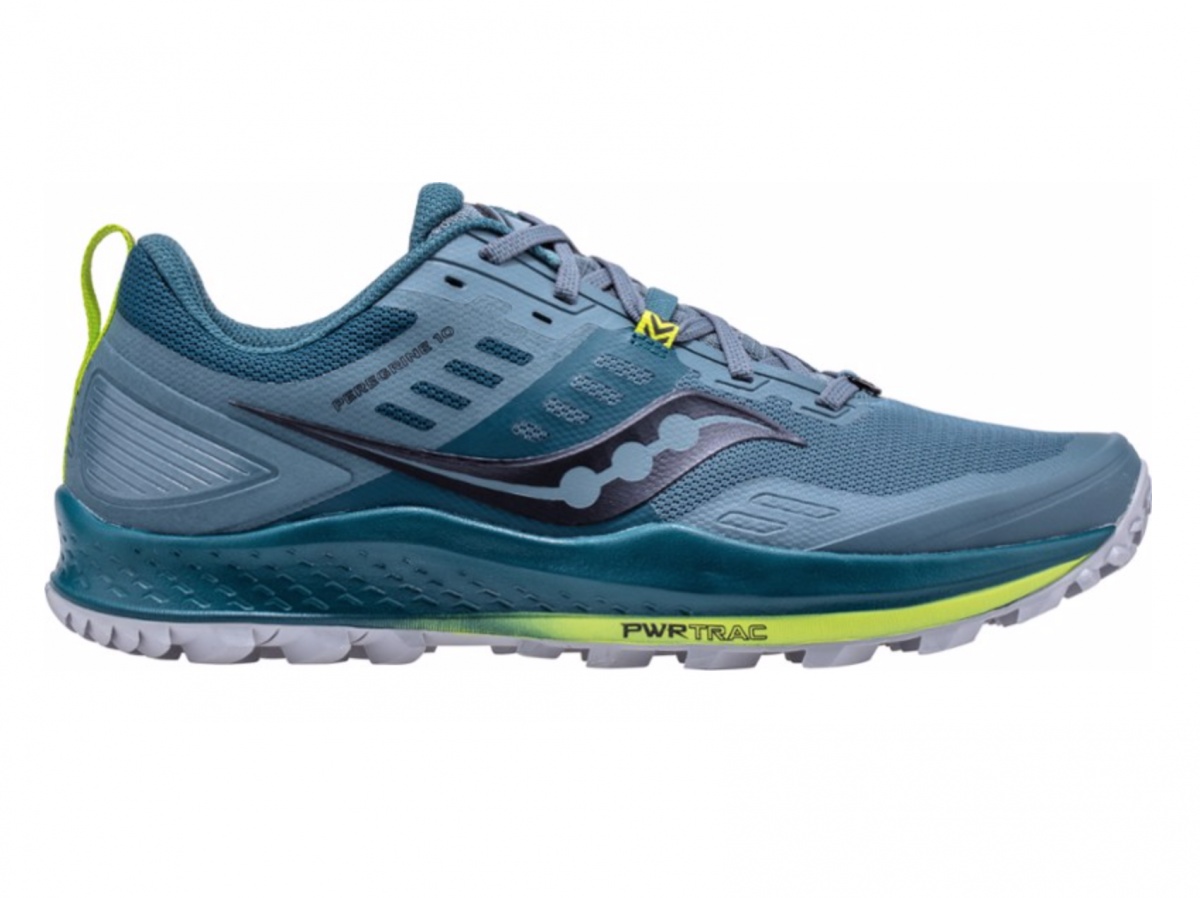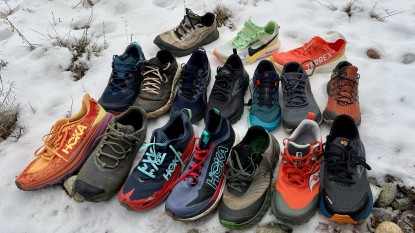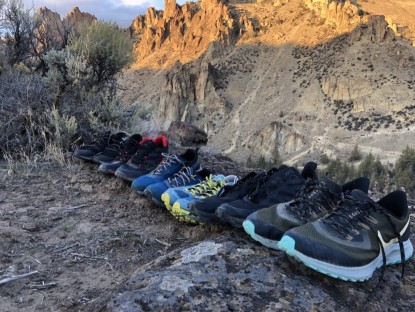Saucony Peregrine 10 Review
Our Verdict
Our Analysis and Test Results
The Saucony Peregrine 10 is a drastic departure from the last few versions of the shoe. Check out the tip box below for more information about the changes. The shoe presents a bit of a paradox. It has a very firm feeling midsole that is not overly flexible and includes a woven rockplate, yet still feels like one of the most sensitive shoes underfoot amongst those we have tested. It has a low stack height that provides a stable ride and also features a thin, lightly cushioned upper, yet is relatively heavy among our selection here. While some attributes of this shoe seem to not make a lot of sense, we can't deny that this shoe is a dream to run in. There are also a couple of other versions of the shoe: the Peregrine 10 ST for softer terrain, which apparently has larger, deeper and far firmer lugs, and the Peregrine 10 GTX, which pairs it with a Gore-Tex liner. This shoe can also be purchased in a wide EE version.
The Peregrine 10 feels like a completely different shoe compared to the ISO. Gone is the overly plush padding that surrounded the foot, and the soft foam midsole. Also gone is the old PWRTRAC outsole that was known for easily tearing off. The new outsole is one solid piece with more widely spaced and slightly shorter lugs. The midsole once again has a rock plate and is more firm underfoot, while the upper is pared down into a very lightly cushioned offering that does a great job holding the foot in place. Longtime Peregrine wearers and new converts alike should love the newest version of this shoe.
Foot Protection
Despite using denser foam underfoot and including the woven rockplate into a midsole that is thin and firm, this shoe remains one of the least protective. Those with strong feet and the ability to nimbly dance over trail obstacles will be rewarded, however. Despite its thinness, the midsole does a good job of dampening the effect of stepping on jagged rocks or scree, but over the course of long runs the feet can still take a bit of a beating. There is a toe bumper that wraps around the entire front of the toe box, but it's made of semi-rigid plastic that feels quite soft. The upper is thin mesh reinforced by print overlays, and offers little in the way of foot protection. While it isn't the least protective shoe we have ever worn, in terms of foot protection, we would describe it as “just enough.”
Traction
The Peregrine has long been known for its insanely aggressive traction, and the newest version is no different, despite the complete change made to the outsole lug pattern. The soft and sticky lugs are now chevron shaped, very similar to many other models of trail running shoes, and are more widely spaced. The 5mm deep lugs have sharp edges for biting into soft surfaces. We found that they do an excellent job on slippery surfaces like soft dirt, mud, snow, and grass, and the rubber is also sticky enough to grip rock well. The outsole is also now made of one whole piece of rubber, which should greatly increase its durability compared to previous versions that often suffered catastrophic tearing due to the thin strips of rubber that it was made of.
Perhaps the most innovative feature of this shoe is the addition on the sole of spots designed for inserting screws for added traction. Oddly, Saucony gives no guidance or recommendation on how this should be done, but short sheeting screws should work well. The addition of screws can add serious bite when running on ice in the winter, not unlike adding studs to your car's snow tires. We did not test this feature because we didn't have ice to run over, and without the explicit need, we don't think it's worth penetrating the sole of the shoe. We would hesitate against adding the screws and then removing them again because the tears to the outsole rubber would likely allow for greater ripping as you transition back to dirt trails. We also think that if you are buying these shoes because of this feature, for running on ice in the winter, you would be wise to go with the GTX version to add some waterproofness against slush and snow.
Stability
This is a very stable shoe, ranking up there with the best, and therefore lending itself well to the most technical terrain. It is easy to lock the foot in well with no slippage in the heel or the forefoot. The secure fit combined with a low midsole stack of only 22mm in the heel, and the same 4mm drop present in all previous versions, keeps one close to the ground. The firm and flat landing platform also allows one to easily push off on uneven terrain. Stability is certainly one of the strongest attributes of this shoe.
Comfort
The fit is accurate, although is trending a bit on the long side, with a pointy toe that seems slightly longer than necessary. Despite this, we feel it fits true to size. Expect a width that is neither overly narrow nor wide, pretty much right in the middle. For those who need a wider fitting shoe, this one is also available in an EE wide version.
This is a comfortable shoe, but with pared down padding, it isn't as comfy as the previous versions. In particular, we experienced a little bit of pressure on the tops of our feet from the laces where the tongue simply wasn't thickly padded enough to provide protection. The heel fits well and doesn't rub like previous versions. Overall a comfy shoe, but not the absolute most comfortable.
In the center of the sole are little circles where Saucony claims you can drill drainage holes to enhance water drainage. To us, this seems like a dubious proposition, and one we chose not to partake in. Our water drainage test, which we have been performing for years, shows us that all shoes drain decently well; they are made of thin, lightweight mesh after all. The differences in performance usually have far more to do with how absorptive the materials used are, as these soak up water if you must pass through a creek for example. Drilling holes through your shoes will very likely compromise the performance and longevity of your outsole, while in no way affecting how absorptive the fabric of the shoe is. Our testing showed that this shoe is slightly better than average in terms of water absorption.
Weight
Our pair of men's size 11 shoes weighed in at 23.0 ounces, which is basically the exact same weight as the previous versions of the shoe.
However, compared to the competition this isn't one of the lightest by any means. The thing is, it feels rather minimal, and therefore also feels like its should be quite light, but it isn't.
Sensitivity
We often find that sensitivity and underfoot protection work at odds with each other, and this is certainly the case with this shoe. While it doesn't feel very protective to us, it feels very sensitive. We love how we can feel the trail beneath our feet without damaging them, and think that trail runners who like a lighter, more sensitive shoe will appreciate the way that this one feels.
Value
In a world where political and economic forces are rapidly driving up the prices of trail running shoes each year, it is refreshing to see a top-level shoe that remains at the same price that it has been for many years. While we wouldn't expect this to be the longest lasting shoe, we like the price, and think it provides good value for the performance.
Conclusion
The Saucony Peregrine 10 is a fantastic upgrade to an already popular shoe. Very little remains the same from the last few versions of this shoe, and almost every change has led to better performance. For those who like a stable, sensitive ride with excellent traction and an affordable price, the Peregrine 10 is one that we can solidly recommend.













